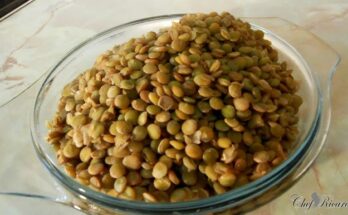Pickled Cabbage Recipe: If you’ve ever wanted to add a pop of flavor, crunch, and nutrition to your meals, pickled cabbage might just be your next kitchen favorite. It’s tangy, crisp, and full of vibrant color—perfect for enhancing everything from sandwiches and salads to tacos and rice bowls. The beauty of pickled cabbage lies in its simplicity: a few basic ingredients and a little patience are all you need to create something extraordinary.
Pickling isn’t just a preservation method—it’s an art form. The process transforms humble cabbage into a flavor-packed condiment bursting with zesty notes. And the best part? You don’t need to be a professional chef to master it. Whether you prefer a quick vinegar pickle or a traditional fermented version, this guide will walk you through every step clearly and easily.
So, roll up your sleeves, grab a cutting board, and let’s turn that plain cabbage into something magical.
What is Pickled Cabbage?
Pickled cabbage is cabbage that’s been preserved in a mixture of vinegar, salt, sugar, and sometimes spices. This process gives it a tangy taste, a delightful crunch, and a long shelf life. Depending on how it’s prepared, it can be enjoyed within a few hours (quick pickle) or aged for weeks (fermented pickle).
Cabbage is an excellent vegetable for pickling because of its natural crispness and ability to soak up flavors beautifully. You can use red or green cabbage—or even a mix for a colorful jar. The pickling process breaks down the cabbage slightly, enhancing its flavor while keeping it refreshingly crunchy.
Culturally, pickled cabbage appears in cuisines across the globe. Germans have their sauerkraut, Koreans their spicy kimchi, and Americans love it as a tangy topping for hot dogs and burgers. Wherever you go, this humble dish finds a place at the table, showing just how universal and beloved it truly is.
Health Benefits of Pickled Cabbage
Aside from its addictive taste, pickled cabbage is a powerhouse of nutrition. Fermented versions, especially, are rich in probiotics, which are beneficial bacteria that promote gut health. A happy gut often means better digestion, stronger immunity, and improved overall wellness.
It’s also low in calories yet high in vitamins—particularly vitamin C, K, and fiber. This makes it a great option for anyone looking to eat healthier without sacrificing taste.
Moreover, pickled cabbage helps balance your body’s microbiome, aiding in nutrient absorption and reducing bloating. If you’re trying to cut down on processed condiments like mayonnaise or dressings, pickled cabbage serves as a flavorful and natural substitute.
In short, this dish doesn’t just make your meals more exciting—it makes your body thank you for it too.
Ingredients You’ll Need
Let’s talk ingredients. To make the perfect batch of pickled cabbage, you don’t need a long list—just a few pantry staples and some fresh produce. Here’s everything you’ll need:
Fresh Vegetables
- 1 medium head of red or green cabbage (or both, for color contrast)
- 1 medium carrot, julienned (optional, adds sweetness and texture)
- 2–3 garlic cloves, thinly sliced
- 1 small onion, sliced (optional for flavor depth)
Pickling Brine Essentials
- 1 ½ cups white vinegar (or apple cider vinegar for a milder tang)
- 1 cup water
- 2 tablespoons sugar (adjust to taste)
- 1 tablespoon salt (non-iodized is best)
Optional Flavor Boosters
- 1 teaspoon mustard seeds
- ½ teaspoon black peppercorns
- ½ teaspoon chili flakes (for a kick)
- 1 bay leaf
- A few sprigs of fresh dill or thyme
These ingredients can be adjusted based on personal taste. Want it sweeter? Add more sugar. Prefer it spicy? Increase the chili flakes. The best part of pickling is making it your own.
Kitchen Tools and Equipment
Before diving into the process, gather your tools to make the experience smooth and efficient. Having the right equipment ensures consistency, hygiene, and ease during the pickling process.
Essential Tools for Pickling
- Sharp knife or mandoline for thinly slicing the cabbage
- Large mixing bowl to toss and massage the cabbage
- Saucepan to heat the brine
- Tongs or spoon for safe handling of hot liquids
Recommended Containers and Storage Tips
- Glass jars (Mason jars or any airtight jar) – clean and sterilized
- Avoid metal or plastic containers, as vinegar can react with them.
- Always make sure jars are completely dry and sanitized to prevent mold growth.
Proper preparation ensures your pickled cabbage remains crisp, safe, and flavorful for weeks to come.
Step-by-Step Guide to Making Pickled Cabbage
Now comes the exciting part—bringing all the ingredients together! Follow this step-by-step process for a perfectly balanced, tangy, and crunchy pickled cabbage.
Step 1 – Prepare the Cabbage
Remove the outer leaves of the cabbage and slice it as thinly as possible. You can use a sharp knife or a mandoline slicer for even pieces. Place the sliced cabbage in a large mixing bowl, sprinkle with a tablespoon of salt, and massage gently for 5–10 minutes. This draws out excess moisture and softens the texture slightly.
Step 2 – Make the Brine
In a saucepan, combine vinegar, water, sugar, and salt. Heat over medium flame until the sugar and salt dissolve completely. Once done, remove from heat and let it cool slightly.
Step 3 – Combine and Pack
Add any optional flavor boosters like garlic, peppercorns, or mustard seeds into sterilized jars. Pack the cabbage tightly into the jars, leaving a little space at the top. Pour the warm brine over the cabbage, ensuring it’s fully submerged.
Step 4 – Ferment and Wait
Seal the jars tightly. If you prefer a quick pickle, refrigerate immediately and let sit for 24–48 hours. For a fermented version, leave the jar at room temperature for 3–5 days, then refrigerate. The longer it sits, the more flavorful it becomes.
Step 5 – Taste, Store, and Enjoy
Once the cabbage reaches your preferred taste, refrigerate it. The pickled cabbage can last for up to 2 months in the fridge. Serve it cold with meals or as a zesty topping for sandwiches.
Tips for Perfect Pickled Cabbage
Getting the balance just right in pickled cabbage can feel like magic. But don’t worry—it’s more about precision than luck. Here are a few golden tips that ensure every batch comes out delicious, crisp, and perfectly tangy.
How to Prevent Mold and Over-Fermentation
One of the most common mistakes beginners make is letting their cabbage ferment too long or not keeping it submerged in the brine. Always ensure that every bit of cabbage stays below the liquid line—air exposure encourages mold. You can use a fermentation weight or a clean piece of cabbage leaf pressed on top to keep it submerged.
If you’re fermenting, don’t seal the jar completely airtight—let some air escape to prevent pressure buildup. For vinegar-based pickles, a tight seal is perfectly fine since you’re not relying on fermentation.
Check the jars daily for the first few days. If you notice bubbles or fizz, that’s normal during fermentation—it means beneficial bacteria are working their magic. However, if you see white or fuzzy mold, discard the batch immediately.
Adjusting Flavor Intensity
Want a bolder tang? Increase the vinegar ratio slightly. Prefer something mellow? Add a bit more sugar to balance the acidity. Red cabbage tends to have a slightly earthy taste, while green cabbage offers a lighter flavor—so you can mix the two for the best of both worlds.
For spice lovers, adding a few slices of fresh chili or a dash of chili flakes gives the pickle a fiery kick. If you enjoy aromatic flavors, toss in coriander seeds, juniper berries, or ginger slices.
Remember, the best pickled cabbage is one that matches your personal taste profile. Adjust, experiment, and enjoy every bite.
How to Store Pickled Cabbage
Proper storage is key to maintaining that satisfying crunch and flavor for weeks or even months. Pickled cabbage can last long, but only if stored correctly.
Refrigeration vs. Room Temperature
Once your cabbage has reached the perfect flavor, always store it in the refrigerator. The cold temperature slows down the pickling process and helps maintain its texture.
If you’ve made a quick vinegar pickle, it should go straight into the fridge once cooled. However, if you’ve gone for a traditional fermentation method, leave the jar at room temperature for 3–5 days before refrigerating it. This gives it time to develop its signature tang and depth of flavor.
Shelf Life and Preservation Tips
- Vinegar Pickles: Can last up to 2–3 months in the fridge.
- Fermented Pickles: Stay fresh for 4–6 months when properly sealed and kept cool.
- Always use clean utensils when scooping out cabbage—never use your hands directly.
- If the cabbage starts smelling off, turns slimy, or changes color drastically, it’s time to make a new batch.
The key is to keep it cold, sealed, and clean. Properly stored pickled cabbage only gets tastier with time!
Variations of Pickled Cabbage Recipes
One of the best things about pickled cabbage is its versatility. Across different cultures, you’ll find dozens of variations, each with its own distinct flavor, texture, and spice level. Let’s explore a few of the most popular ones.
Korean-Style Kimchi
Kimchi is arguably the most famous form of pickled cabbage. Originating from Korea, it’s a fermented dish made with Napa cabbage, garlic, ginger, chili flakes (gochugaru), fish sauce, and green onions. Kimchi isn’t just a side dish—it’s a staple in Korean cuisine and pairs wonderfully with rice, noodles, or grilled meats.
To make a simple kimchi version at home, mix shredded Napa cabbage with salt and let it sit for a few hours. Then, prepare a paste of garlic, ginger, chili flakes, and fish sauce. Combine everything, pack it into jars, and let it ferment for 3–5 days at room temperature before refrigerating.
German Sauerkraut
In Germany, sauerkraut is a national treasure. It’s made by fermenting finely shredded green cabbage with salt—no vinegar required. The natural bacteria on the cabbage leaves do all the work, producing lactic acid, which gives sauerkraut its distinct tang.
Sauerkraut is typically served alongside sausages, roasted meats, or potatoes. It’s mildly sour, crisp, and loaded with probiotics.
Spicy Garlic Pickled Cabbage
For those who love bold, zesty flavors, spicy garlic pickled cabbage is a perfect twist. Simply add sliced garlic, chili flakes, and a few peppercorns to your brine before pouring it over the cabbage. The result? A fiery, aromatic pickle that pairs beautifully with sandwiches, tacos, or grilled fish.
Serving Suggestions
Pickled cabbage is more than just a condiment—it’s a flavor enhancer that can elevate almost any dish. Its tangy crunch complements both heavy and light meals beautifully.
As a Side Dish
Pickled cabbage works wonderfully as a side dish for grilled meats, fried rice, dumplings, or even simple stir-fries. It cuts through the richness of fatty foods, balancing out flavors with its acidic punch.
You can also serve it alongside roasted potatoes, barbecue dishes, or even as part of a charcuterie board for a splash of color and zest.
In Sandwiches and Salads
Want to upgrade your sandwich or salad game? Add a spoonful of pickled cabbage! It pairs amazingly with pulled pork sandwiches, burgers, and wraps, adding a crunchy, vinegary bite.
For salads, toss some pickled cabbage into coleslaw or mix it with greens, avocado, and grilled chicken for a refreshing and tangy twist. It’s also perfect in tacos or burrito bowls for that extra layer of flavor.
Think of it as your kitchen’s secret weapon—small in portion but big on impact.
Common Mistakes to Avoid
Even though making pickled cabbage is simple, a few common mistakes can ruin your batch. Here’s what to watch out for:
Over-Salting or Under-Salting
Salt is crucial in pickling—it draws out moisture and enhances flavor. Too much salt, however, can make your cabbage unpleasantly briny. Too little, and it won’t preserve properly. The ideal ratio is roughly 1 tablespoon of salt per 1 pound of cabbage.
Always use non-iodized salt like kosher or sea salt. Iodized salt can interfere with the fermentation process and cloud your brine.
Using the Wrong Type of Vinegar
Not all vinegars are equal. White vinegar gives a sharp tang, while apple cider vinegar adds a softer, fruity note. Avoid balsamic or malt vinegar—they can overpower the flavor and darken your cabbage.
Another tip: Always dilute vinegar with water for a balanced taste. Straight vinegar can make your pickles too acidic.
By steering clear of these common pitfalls, you’ll ensure every jar of pickled cabbage turns out perfectly crisp and flavorful.
FAQs about Pickled Cabbage Recipe
1. How long does pickled cabbage last in the refrigerator?
Properly sealed and refrigerated, pickled cabbage can last up to 2–3 months for vinegar-based recipes and 4–6 months for fermented versions.
2. Can I use purple cabbage instead of green cabbage?
Absolutely! Purple cabbage not only looks stunning but also adds a slightly sweeter taste to your pickles.
3. Why is my pickled cabbage soft instead of crunchy?
Overheating the brine or leaving the cabbage too long before refrigerating can soften it. Always pour slightly cooled (not hot) brine over the cabbage.
4. Can I reuse the leftover brine?
It’s best to make fresh brine for every new batch to ensure safety and consistent flavor.
5. Is pickled cabbage the same as kimchi or sauerkraut?
Not exactly. Kimchi is a spicy, fermented Korean dish, while sauerkraut is a plain, fermented German version. Pickled cabbage can be either quick-pickled or fermented, depending on your recipe.
Conclusion
Pickled cabbage is one of those rare recipes that combine simplicity, flavor, and health in every bite. Whether you enjoy it as a quick pickle or go for a deeper, fermented flavor, it’s an easy way to add zest and color to your meals.
From boosting your gut health to turning an ordinary sandwich into something extraordinary, this humble dish truly does it all. The best part? You can make it your own—sweet, spicy, garlicky, or mild.
So, the next time you have a head of cabbage sitting in your fridge, don’t let it go to waste. Turn it into something delicious, nutritious, and downright addictive.



